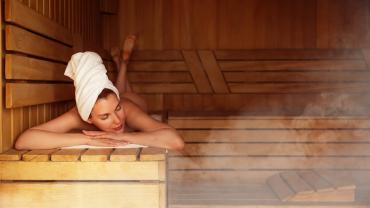
Detoxifying through Sweating
Sweating is considered one of the main routes of detoxification in the human body, particularly for heavy metals. Nickel, lead, and chromium have been reported to be 10 to 30 times higher in sweat concentration compared to blood and urine. Some evidence suggests that excretion rates of arsenic, cadmium, lead, and mercury through sweating may match or even exceed the urinary excretion of these metals in a 24-hour window. Removing these toxic heavy metals from the body can support overall health as the metals have been shown to interfere with normal protein function and enzyme activity, potentially impacting the health of the nervous, endocrine, renal, musculoskeletal, immunological, and cardiovascular systems. Sweating may also promote the excretion of other toxicants, such as persistent flame retardants, organochlorine pesticides, bisphenol-A, phthalates, or various petrochemicals.
Using Saunas to Help Detox
A dry heat sauna can get as high as 185°F, increasing the skin temperature to about 104°F in just a few minutes. The pulse rate elevates by about 30% or more, and the heart nearly doubles the amount of blood pumped each minute. A study performed by Harvard Medical School concluded that the average person loses roughly one pint of fluid through sweat during a sauna session of no more than 20 minutes.
Sauna dry bathing can be considered a clinically beneficial lifestyle factor to support detoxification, whether as a part of a controlled detox plan or for general use. While a small clinical study (n = 12) concluded that vigorous exercise may be more effective in removing heavy metals (nickel, lead, copper, and arsenic) through sweating than static exposure in a sauna, sauna bathing may be especially relevant to individuals who do not or unable to exercise routinely. Sauna bathing may also complement various forms of exercise to potentially reduce an individual's toxin burden.
Maintaining Proper Hydration and Electrolyte Balance during Sauna Bathing
Moderate-temperature sauna bathing should be complemented with fluid and electrolyte restoration before, during, and after the session. Sauna bathing helps to promote the beneficial removal of heavy metals but also induces the loss of electrolytes – essential minerals that help to maintain fluid balance and cellular health of the heart and nerves. Significant electrolytes for the body are sodium, potassium, chloride, magnesium, calcium, phosphate, and bicarbonate, which can come from foods, fluids, or supplements. An imbalance in these electrolytes can disrupt normal bodily functions and lead to symptoms like headaches, fatigue, or even severe conditions. Sweat and exposure to hot environments (such as a sauna) are the largest sources of electrolyte and water loss.
Although fluid loss during sauna bathing is typically not severe, adequate replacement of fluid and electrolyte loss is recommended as early as possible during a cool-off period. The amount of fluid and electrolyte loss due to sweating will depend on numerous factors that vary from person to person, such as length of time in the sauna, acclimatization, type of heat used, or fitness level. Harvard Medical School recommends that a person drink two to four glasses of cool water after each sauna use. However, water alone does not replenish the electrolytes lost due to sweat; they must be added to fluids or consumed throughout the diet. Moreover, fluid replenishment and restoring electrolyte balance before a sauna bath begins may be necessary if it occurs after heavy physical exercise. Sauna bathing should be used under medical supervision for children, individuals of older age, or those with compromised health, such as uncontrolled hypertension, heat intolerance, dysautonomia, or heart disease.
By Danielle Moyer Male, MS, CNS LDN